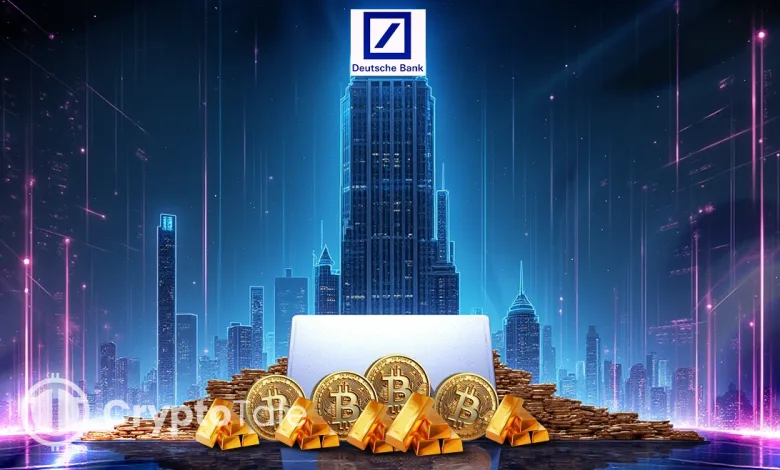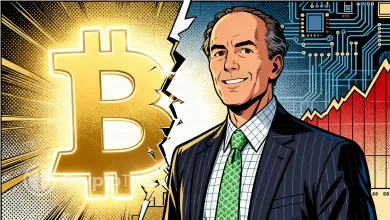Deutsche Bank: Central Banks May Hold Bitcoin and Gold by 2030

- Deutsche Bank predicts central banks will hold Bitcoin and gold as key reserves by 2030.
- The bank says Bitcoin’s volatility drop makes it a modern cornerstone of financial security.
- Analysts see Bitcoin and gold as complementary hedges in a multipolar reserve system.
Deutsche Bank has projected that central banks may hold significant amounts of Bitcoin and gold by 2030. Analysts at the German multinational investment bank believe Bitcoin could evolve into a “modern cornerstone of financial security.” The report, authored by senior economist Marion Laboure and analyst Camilla Siazon, outlines how the asset’s role may mirror gold’s status in the 20th century.
Bitcoin has traded above $125,000 in October 2025, while gold trades around $4,000 an ounce. According to Deutsche Bank, this dual rally is an indication of increasing confidence in both assets as long-term stores of value.
A Shift Toward Digital and Hard Assets
Deutsche Bank’s research highlights that many central banks are preparing for a multipolar reserve system. This system could include traditional and digital assets such as gold and Bitcoin. The analysts noted that Bitcoin’s volatility has fallen to its lowest level in history, strengthening its appeal to central institutions.
According to the report, the dollar’s share in global reserves has dropped from 60% in 2000 to just 41% in 2025. The researchers wrote that Bitcoin now shares key traits with gold – scarcity, liquidity, and independence from any single government. These characteristics make both assets valuable hedges against inflation and political risk. As global uncertainty rises, central banks are looking for alternatives that can safeguard value beyond fiat systems.
Countries like China, India, Brazil, and Turkey are already considering abandoning the dependence on the dollar. To cushion their economies against the U.S monetary policy changes and sanctions, many are accumulating more gold reserves. Deutsche Bank said this trend is likely to extend to Bitcoin as it becomes a more stable and credible asset.
Central Banks Prepare for a New Reserve Model
The report suggests that the next phase of global reserve management may involve both gold and Bitcoin. This model reflects a move toward financial resilience rather than full replacement of the dollar. Laboure wrote that Bitcoin and gold should be viewed as complementary to traditional reserve currencies, not substitutes.
Gold’s resurgence began after the 2008 financial crisis when central banks became net buyers. Today, more than 36,000 tons of gold sit in central bank vaults worldwide. The current surge in prices shows how geopolitical uncertainty continues to drive a “flight to safety.”
Bitcoin seems to be on the same course. Its increasing institutional need, a surge in the trading volumes, and maturing market structure hint at something more than speculation. Central banks, once cautious about digital assets, are now considering Bitcoin’s potential for diversification.
Related: Investors Turn to Bitcoin and Gold as U.S. Debt Nears $38T
While critics continue to argue that Bitcoin has no inherent value, Deutsche Bank contradicts by stating that improved liquidity and reduced volatility are positively influencing the perception. The bank emphasized that digital assets now attract stronger regulatory support, particularly in major markets such as the United States and China.
At the same time, global investors are losing their confidence in fiat currencies due to inflation and fiscal strain. The decentralized nature of Bitcoin offers it an edge to nations seeking to gain independence from U.S. influence.
Bitcoin as Digital Gold
The report by Deutsche Bank supports the argument of Bitcoin as digital gold. Both assets have limited supply and are not controlled by the state. The bank believes that Bitcoin’s role within official reserves will expand as it continues to mature.
By then, Deutsche Bank anticipates a financial world shaped by a hybrid system, where gold preserves legacy trust and Bitcoin symbolizes digital resilience. The analysts concluded that neither Bitcoin nor gold will replace the U.S. dollar. However, both are expected to become vital components of global financial security by 2030.





